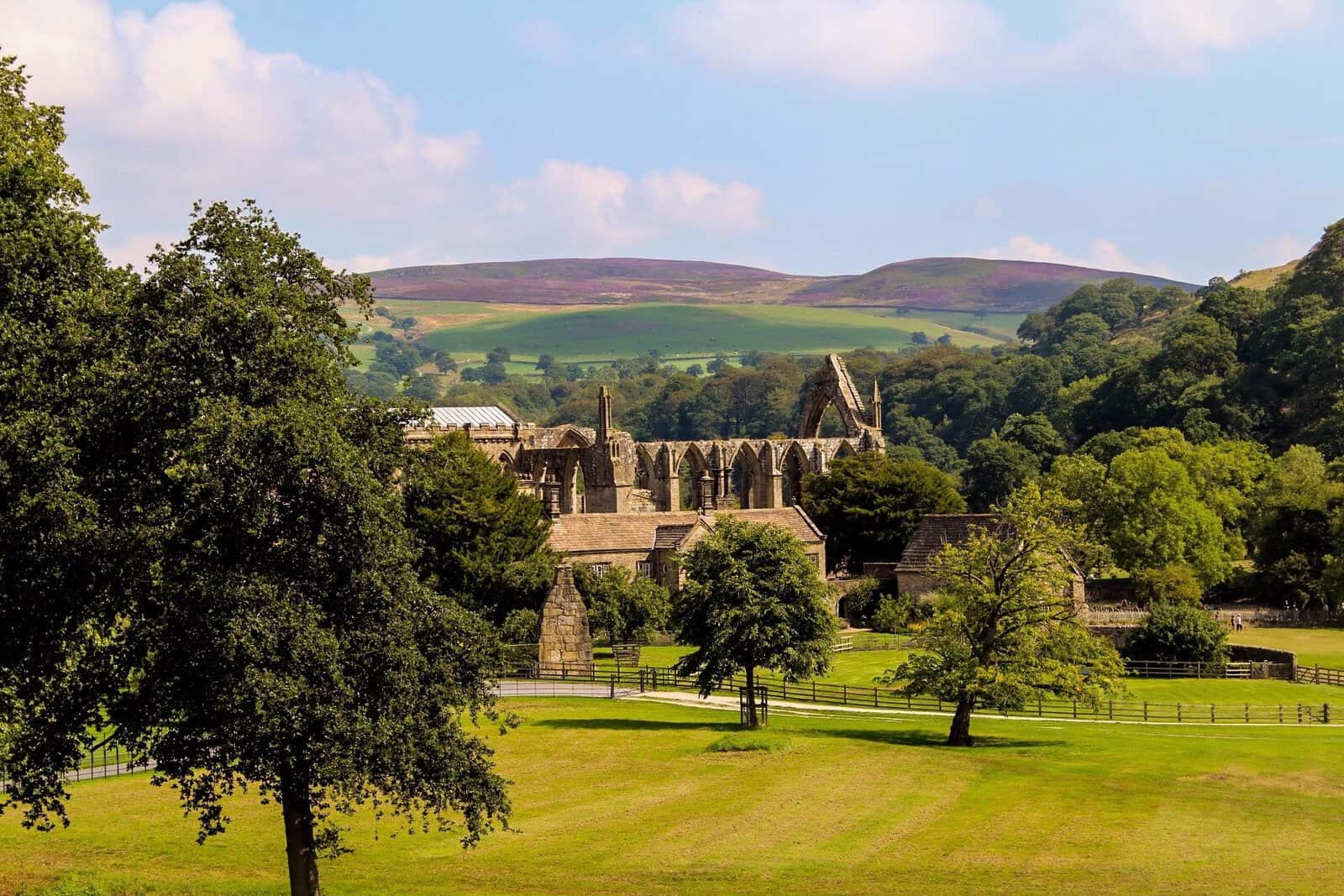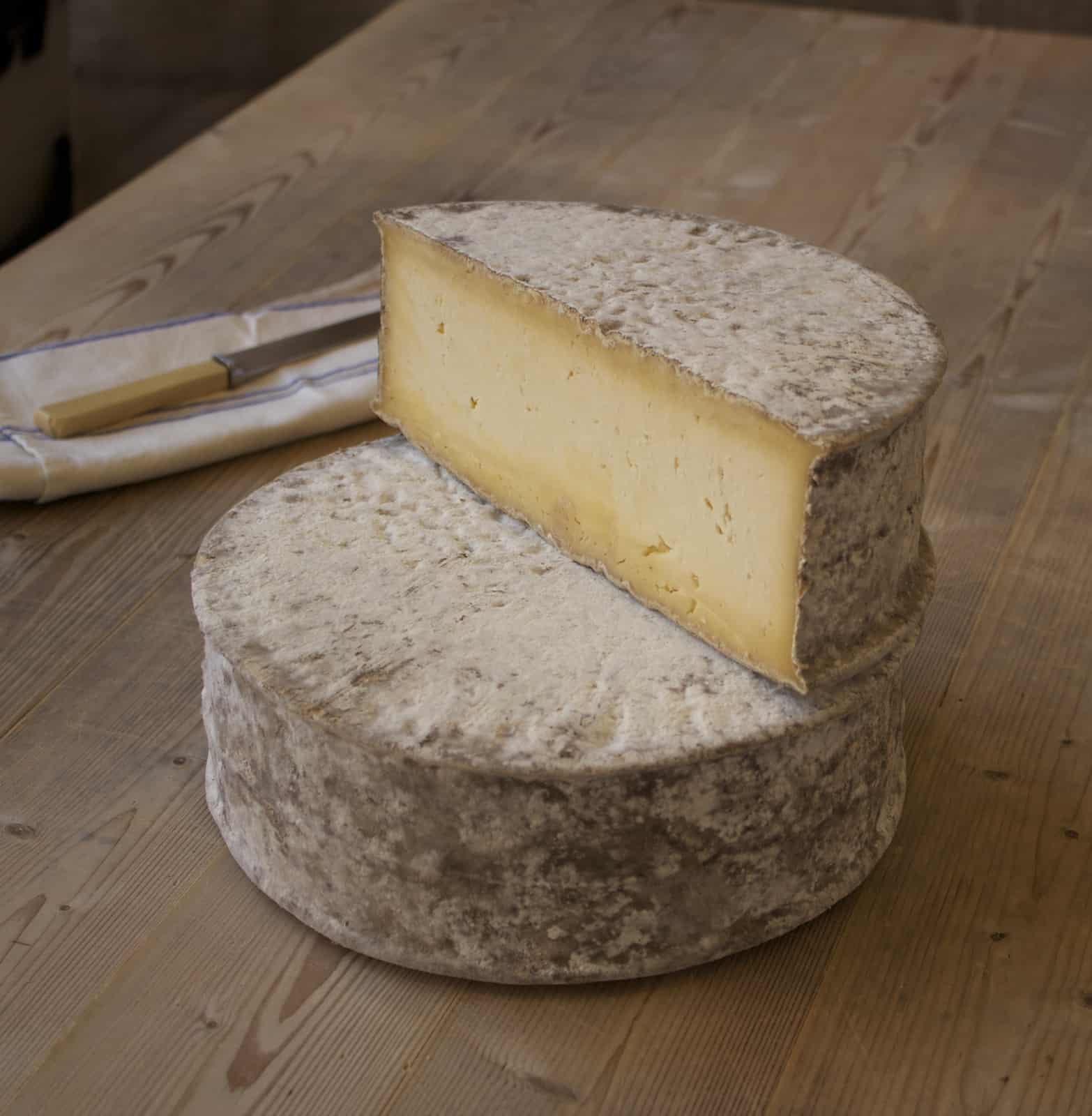
Best Region: Somerset, England
If you stick a pin in a map of Great Britain, chances are it won’t land far from a cheese-laden farmers’ market—but there’s one region that should always be a touring turophile’s first stop: Somerset. An agricultural heartland of low, rolling hills and patchwork plains, Somerset is synonymous with cheddar. The town of Cheddar is here, as well as the nearby Cheddar Gorge, a stunningly rugged limestone gorge in the Mendip Hills. Enjoy rock climbing, hiking, and cycling on the trails of the latter, or visit the Gorge’s caves for spelunking adventures that feature aging wheels of cheese.
But Somerset is more than just cheddar—its goat’s cheese tradition is as old as the Mendip Hills, and there’s always been a strong caerphilly presence as well (the county does face Wales, after all). For a deep dive into local culture, grab a pint of West Country “scrumpy” (local cider) amid the prize bulls of the Royal Bath and West Show in late May, which is also home to the British Cheese Awards (if you’re visiting in early September, drop by the Frome Agricultural and Cheese Show for a similar rustic smorgasbord).

In the county’s north, the UNESCO World Heritage City of Bath is renowned for its honey-colored (or should we say cheese-colored?) stone buildings. Two spectacular cheese shops—Paxton & Whitfield and The Bath Fine Cheese Co.—serve the winding lanes of the compact city center, while Bath Soft Cheese sits on a hillside just a short drive out of town. Stop by their on-site café for delectable cheese toasties (a.k.a grilled cheese) and, in sunnier seasons, organic milkshakes.
Speaking of sun, August offers a prize attraction in Somerset—Westcombe Dairy’s annual Beer and Cheese Festival, a collaboration with craft beer pioneers Wild Beer Co. With both companies on-site in the village of Westcombe, you’ll follow signs through the trees to a welcome of artisan cheddar toasties, tastings of Duckett’s Caerphilly and Westcombe cheddar, and foaming glasses of Britain’s best barrel-aged sours.
Best Cheesemakers of the U.K.
Bath Soft Cheese Company
The Padfield family has made cheese on this gently sloping hillside just outside the city of Bath for four generations. While the first generation made cheddar, the current one crafts many other varieties from its 160-strong Holstein-Friesian herd.
This year, Bath Blue (Best Blue Cheese at the Artisan Cheese Awards), washed-rind Merry Wyfe (Best Organic Cheese at the British Cheese Awards), and the eponymous Bath Soft Cheese, a white bloomy-rind tile (Best Organic Cheese at the Artisan Cheese Awards) share the spotlight. The unusual square shape of the last is due to the company’s adherence to a centuries-old recipe for “Bath Cheese” that founder Graham Padfield found in an old grocer’s book in 1990. His son, Hugh (who now runs the business), is quick to note that—unlike in the found recipe—a feather isn’t used to salt the cheese.
Which isn’t to say that they eschew traditional methods. In fact, it’s a point of pride that they still hand-pierce their blue cheeses, a technique that Hugh insists helps his cheesemakers judge the ripeness of each individual wheel. “The milk from our herd of cows changes dramatically through the year,” he explains. “It’s watery in spring, full of protein in autumn, thick and gooey milk in winter. To properly account for these changes in milk and environment, it’s important that we apply hand techniques, using no technology that distances us from our cheese. Nothing beats touching, smelling, and tasting.”
This touching, smelling, and tasting also occurs in ritualistic fashion at the end of each week, when Hugh sits down with his cheesemakers to unwind and taste the wheels that are currently “in life.” While the emphasis is on kicking back—wine from the on-site café might be uncorked for sampling—detailed notes are taken on a wide selection of their ripe cheeses.
Besides this structured approach to reviewing the product and their attention to detail throughout the cheesemaking process, Hugh believes his people are what set their award-winning operation apart. “We’ve been very lucky to have created a team of cheesemakers and other staff who are passionate about cheese, passionate about organic, and passionate about farming,” he says.

Photo by J. Miller
White Lake Cheese
“There’s only so much you can do with cheese,” says Peter Humphries, co-owner of White Lake Cheese along with Roger Longman. It’s an extraordinary statement considering the source: Somerset-based White Lake has quietly built a formidable reputation for delivering delicious, imaginative cheeses—a reputation recently cemented by a British Cheese Awards first: back-to-back Supreme Champion wins…with two different cheeses.
Clearly, there’s a natural chemistry at White Lake that’s leading to a line of new modern classics. It was two sheep’s milk cheeses that bagged their historic double: first, in 2017, Pavé Cobble, a lactic-set, ash-dusted pyramid named after the difficult, cobbled stretches of the Tour de France, followed by the semi-firm Sheep Rustler, an ovine tweak of their lauded goat cheese, Rachel. For Humphries, both Supreme Champions brought something a little different to the judging table.
“The Pavé we put in was young and mousse-like, which a lot of the judges liked,” he explains, “whereas Sheep Rustler was probably a bit sweeter, more toffee-like than the cheeses it was up against.”
When asked whether there’s been any in-house innovating of late that might have prompted this current season of supremacy, Humphries is unassuming, but says, “We’re always trying to make the cheese better. Even when you have a recipe to work to, you’re always trying to look for ways to improve. I don’t think any cheese is ever fully developed.”
Which leaves the pair with a lot to cogitate upon: Currently there are 28 cheeses being produced under the White Lake banner (that’s about 100 tons per year). Based on the Longman family’s Bagborough Farm with its 700-strong mixed goat herd, White Lake’s initial focus when launched in 2005 was, naturally enough, on goat cheese. But with a steady supply of rich Guernsey cow’s milk only 10 minutes away and sheep’s milk also available locally, the company now exports a wide swath of artisan treats to the US, Europe, and as far afield as Australia.
So why hasn’t such a prolific Somerset cheesemaker attempted a cheddar yet? They haven’t had time, Humphries says. “It would be nice to see how well we could make it,” he says, “but there are a lot of other cheeses we want to make first.”

Best Cheeses of the U.K
Duckett’s Aged Caerphilly
Westcombe Dairy
Westcombe, United Kingdom
This cheese is named for Chris Duckett, whose recipe Westcombe Dairy employs to produce this traditional caerphilly. Duckett—who taught the producer of the much-lauded Gorwydd Caerphilly—passed on the 20-year-old brine to Westcombe, which is credited with bestowing the natural flora on this four-month-aged cow’s milk cheese. Fresh with a lactic tang, expect grass and mushroom flavors from the pale, crumbly paste.
Killeen Goat Mature
Killeen Farmhouse Cheese
Portumna, Ireland
Aged for a minimum of five months—three more than the regular version of this goat gouda—pasteurized Killeen Goat Mature is covered in a thin plastic coating before being aged on wooden boards. The beige paste offers an earthy, umami flavor—a judge at the British Cheese Awards noted a similarity to Marmite—and toasted hazelnut notes. Small calcium lactate crystals add a pleasing crunch.
Kit Calvert Old-Style Wensleydale Cheese
Wensleydale Creamery
Wensleydale, United Kingdom
Kit Calvert—“the father of Wensleydale cheese”—helped save this creamery from closure by turning it into a farmers’ cooperative in the 1930s, and thus has a wheel named after him. Clothbound and matured for a maximum of 14 weeks—longer than a typical Wensleydale—this pasteurized cow’s milk drum is turned once a week to manage its high moisture content. The vibrant acidity typical of Wensleydale is balanced by this more mature version’s buttery character, although—happily—the paste remains flaky and moist.
The Merry Wyfe
Bath Soft Cheese Company
Kelston-near-Bath, United Kingdom
Take Bath Soft Cheese’s gouda-style Wyfe of Bath and wash it in the cheesemaker’s own fizzy, French-style cider and you’ve got The Merry Wyfe. This version is also pressed, and after being cider-washed every other day for four weeks, is thoroughly rubbed to embed the sticky nutrients and salt into the pungent rind. The succulent, fudgy paste beneath has a complex flavor with grassy notes. Did we mention it’s also organic and vegetarian?

Montgomery’s Extra Mature Cheddar
Montgomery’s Cheddar
Yeovil, United Kingdom
Take one of the world’s top artisan cheddars…and age it a few months longer. The result—a profoundly delicious piece of cheddar history—is Montgomery’s Extra Mature Cheddar. The pronounced broth and nut flavors of the dry, crumbly paste also offer a spicy, peppercorn edge and a lengthy, warming finish.
Rachel
White Lake Cheese
Pylle, United Kingdom
Using brine to wash undesirable mold off a hard goat’s milk cheese led Peter Humphries to create this multiple award winner. Rachel—named for a friend of Humphries—has a supple, ivory interior and a dusky orange rind thanks to its signature brine wash. Produced using thermized milk and vegetarian rennet, Rachel’s mellow flavor is sweet and slightly nutty (sharing the same qualities, apparently, as Peter’s friend), with minimal goatiness.
St Bartholomew
Nettlebed Creamery
Henley-on-Thames, United Kingdom
Described as “St. Nectaire meets Comté,” this highly approachable, modern cheese is made from pasteurized organic cow’s milk. Following a typical Alpine-style recipe, the handsome semi-firm round has a pliable paste and, after a minimum maturation of six months, develops a delicious fruity flavor with caramel and hazelnut notes. The name is a nod to a local church.

Colston Bassett Dairy Ltd.
Colston Bassett, United Kingdom
A holiday classic, Colston Bassett Stilton is made from pasteurized cow’s milk per PDO requirements, then hand-ladled into molds and pressed before being aged for a minimum of eight weeks. The addictively fudgy paste offers a deep creaminess with herbaceous notes and a signature yet subtle blue tang.
Smoked Mull of Kintyre
Campbeltown Creamery
Campbeltown, United Kingdom
Smoked cheeses tend to be on the younger side, so when Campbeltown Creamery decided to smoke its rugged, punchy mature cheddar, it was uncharted territory. Cold-smoked over oak chips for 14 hours, Smoked Mull of Kintyre has a burnt caramel–colored exterior and a deep gold paste. The smoke hits first on the palate, but unlike most smoked cheddars, the savory sharpness rises and unfolds into a long, satisfying finish.
The Three Sisters
Galway Goat Farm
Dunmore, Ireland
A lactic, pasteurized goat’s milk button, The Three Sisters is often sold at four weeks old but capable, according to cheesemaker Larry Maguire, of “running on.” The paste is sunny yellow and the rind a powdery white, its aroma honeyed and floral with a hint of straw, and its flavor lemony with a mild goatiness. If allowed to “run on,” the flavors deepen and the interior liquifies.




